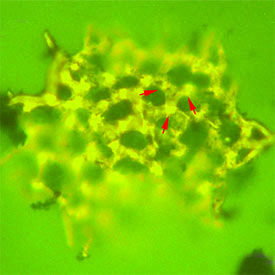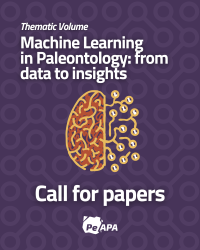FIRST TITHONIAN RECORD OF PERFORATED PEDIASTRUM MEYEN S.L. SPECIES WITHIN EARLY–DIAGENETIC CARBONATE CONCRETIONS FROM THE VACA MUERTA FORMATION, NEUQUÉN BASIN, ARGENTINA. IMPLICATIONS FOR THE PALYNOLOGICAL ANALYSIS OF FINE-GRAINED ROCKS
DOI:
https://doi.org/10.5710/PEAPA.04.08.2023.474Keywords:
Pediastrum Meyen s.l., Vaca Muerta Formation, Tithonian, Neuquén Basin, ArgentinaAbstract
The perforated Pediastrum Meyen s.l. species are recorded for the first time in the basal levels of the Tithonian Vaca Muerta Formation, extending its first stratigraphical record to ages as old as Late Jurassic times. Based on the ecological requirements of Pediastrum simplex var. clathratum and P. simplex var. biwaense, the previously warm paleoclimatic conditions suggested by the Late Jurassic of Neuquén Basin, are reinforced. The co-occurrence of the different mechanisms that interacted during the transport, accumulation, and early diagenesis of these sediments and their organic content would have allowed for the excellent preservation of the Pediastrum Meyen s.l. species.
References
Batten, D. J. (1996). Chapter 7C. Colonial Chlorococcales. In J. Jansonius and D. C. McGregor (Eds.), Palynology: Principles and applications (Vol. 1, pp. 191–203). American Association of Stratigraphic Palynologists Foundation.
Buchheim, M., Buchheim, J., Carlson, T., Braband, A., Hepperle, D., Krienitz, L., Wolf, M. and Hegewald, E. (2005). Phylogeny of the Hydrodictyaceae (Chlorophyceae): Inferences from rDNA data. Journal of Phycology, 41(5), 1039–1054. https://doi.org/10.1111/j.1529-8817.2005.00129.x
Carbone, O., Franzese, J., Limeres, M., Delpino, D. and Martínez, R. (2011). El Ciclo Precuyano (Triásico Tardío-Jurásico Temprano) en la Cuenca Neuquina. In H.A. Leanza, C. Arregui, O. Carbone, J. C. Danieli, J. M. Vallés (Eds.) Geología y Recursos Naturales de la Provincia del Neuquén (pp. 63–75). Relatorio del 13° Congreso Geológico Argentino, Neuquén.
Casadío, S. and Montagna, A. O. (2015). Estratigrafía de la Cuenca Neuquina. In J. J. Ponce, A. O. Montagna and N. Carmona (Eds.), Geología de la Cuenca Neuquina y sus sistemas petroleros: Una mirada integradora desde afloramiento al subsuelo (1a ed., pp. 8–21). Fundación YPF-Universidad Nacional de Río Negro.
Decho, A. W. and Gutierrez, T. (2017). Microbial Extracellular Polymeric Substances (EPSs) in Ocean Systems. Frontiers in Microbiology, 8. https://www.frontiersin.org/articles/10.3389/fmicb.2017.00922
Delcourt, P. A. and Delcourt, H. R. (1980). Pollen preservation and quaternary environmental history in the Southeastern United States. Palynology, 4(1), 215–231. https://doi.org/10.1080/01916122.1980.9989209
El-Noamani, Z. M. and Saleh, A. (2018). Cretaceous Algal Palynomorphs from Northeast Sinai, Egypt: Systematics and Paleoenvironmental Implications. Egyptian Journal of Botany, 58(1), 63–72. https://doi.org/10.21608/ejbo.2017.1838.1127
Fukushima, H. (1956). A list of Japanese freshwater algae. Including the marine species of blue-green algae and fossil diatoms 2. The Journal of Yokohama Municipal University, 13(6), 1–13.
Howell, J. A., Schwarz, E., Spalletti, L. A. and Veiga, G. D. (2005). The Neuquén Basin: An overview. Geological Society, London, Special Publications, 252(1), 1–14. https://doi.org/10.1144/GSL.SP.2005.252.01.01
Jena, M. and Adhikary, S. P. (2007). Chlorococcales (Chlorophyceae) of Eastern and North-eastern States of India. Algae, 22(3), 167–183. https://doi.org/10.4490/algae.2007.22.3.167
Ji, L., Yan, K., Meng, F. and Zhao, M. (2010). The oleaginous Botryococcus from the Triassic Yanchang Formation in Ordos Basin, Northwestern China: Morphology and its paleoenvironmental significance. Journal of Asian Earth Sciences, 38(5), 175–185. https://doi.org/10.1016/j.jseaes.2009.12.010
Komárek, J. and Jakovská, V. (2001). Review of the Green Algal Genus Pediastrum; Implication for Pollen-analytical Research (Vol. 108). J. Cramer.
Kowalska, J. and Wołowski, K. (2010). Rare Pediastrum species (Chlorophyceae) from Polish coastal lakes. Acta Societatis Botanicorum Poloniae, 79(3), Article 3. https://doi.org/10.5586/asbp.2010.028
Legarreta, L. and Uliana, M. A. (1991). Jurassic-Marine Oscillations and Geometry of Back-Arc Basin Fill, Central Argentine Andes. In D. I. M. Macdonald (Ed.), Sedimentation, Tectonics and Eustasy (pp. 429–450). John Wiley & Sons, Ltd. https://doi.org/10.1002/9781444303896.ch23
Lenarczyk, J. (2015). Pediastrum Meyen sensu lato (Chlorophyceae) in the phytoplankton of lowland and upland water bodies of Central Europe (Poland). Fottea, 15(2), 165–177.
McManus, H. A. and Lewis, L. A. (2005). Molecular phylogenetics, morphological variation and colony-form evolution in the family Hydrodictyaceae (Sphaeropleales, Chlorophyta). Phycologia, 44(6), 582–595. https://doi.org/10.2216/0031-8884(2005)44[582:MPMVAC]2.0.CO;2
McManus, H. A. and Lewis, L. A. (2011). Molecular Phylogenetic Relationships in the Freshwater Family Hydrodictyaceae (sphaeropleales, Chlorophyceae), with an Emphasis on Pediastrum Duplex. Journal of Phycology, 47(1), 152–163. https://doi.org/10.1111/j.1529-8817.2010.00940.x
McManus, H. A., Lewis, L. A. and Schultz, E. T. (2011). Distinguishing Multiple Lineages of Pediastrum Duplex with Morphometrics and a Proposal for Lacunastrum Gen. Nov1. Journal of Phycology, 47(1), 123–130. https://doi.org/10.1111/j.1529-8817.2010.00941.x
Mosquera, A., Silvestro, J., Ramos, V. A., Alarcón, M. and Zubiri, M. (2011). La Estructura de la dorsal de Huincul. In: In H.A. Leanza, C. Arregui, O. Carbone, J. C. Danieli, J. M. Vallés (Eds.) Geología y Recursos Naturales de la Provincia del Neuquén (pp. 385–397). Relatorio del 13° Congreso Geológico Argentino, Neuquén.
Mutti, E., Gulisano, C.A. and Legarreta, L. 1994. Anomalous systems tracts stacking patterns within 3° order depositional sequences (Jurassic - Cretaceous back-arc Neuquén Basin, Argentine Andes). In H.W. Posamentier and E. Mutti (Eds.) Abstracts of the Second High Resolution Sequence Stratigraphy Conference (pp.137–143). Tremp.
Nader, A. and Kddo, Y. (2018). Pediastrum Species and Others Coccal Green Algae from Butmah Formation in Borehole Kand-1 Northern Iraq. International Journal of Enhanced Research in Science, Technology & Engineering, 7(3), 7. https://doi.org/10.13140/RG.2.2.32899.76327
Olivera, D. E., Martínez, M. A., Zavala, C., Otharán, G., Marchal, D. and Köhler, G. (2018). The gymnosperm pollen Shanbeipollenites proxireticulatus Schrank from the Vaca Muerta Formation (Upper Jurassic–Lower Cretaceous), Neuquén Basin, Argentina. Cretaceous Research, 90, 120–130. https://doi.org/10.1016/j.cretres.2018.04.003
Otharán, G., Zavala, C., Schieber, J., Olivera, D., Martínez, M., Díaz, P., Yawar, Z. and Agüero, L. S. (2022). Unravelling the fabrics preserved inside early diagenetic concretions: Insights for the distribution, accumulation and preservation of organic-rich mud in the interior of epicontinental basins. Sedimentary Geology, 106254. https://doi.org/10.1016/j.sedgeo.2022.106254
Pacton, M., Gorin, G. E. and Vasconcelos, C. (2011). Amorphous organic matter –Experimental data on formation and the role of microbes. Review of Palaeobotany and Palynology, 166(3), 253–267. https://doi.org/10.1016/j.revpalbo.2011.05.011
Rees, P., Zeigler, A. and Valdes, P. (2000). Jurassic Phytogeography and Climates: New Data and Model Comparisons. In H. null, B. MacLeod and S. K Wing (Eds.), Warm Climates in Earth History (pp. 297–318). Cambridge University Press.
Sha, J. (2007). Cretaceous stratigraphy of northeast China: Non-marine and marine correlation. Cretaceous Research, 28(2), 146–170. https://doi.org/10.1016/j.cretres.2006.12.002
Songtham, W., Ratanasthien, B. and Mildenhall, D. C. (2003). Oligocene-Miocene climatic changes in northern Thailand resulting from extrusion tectonics of Southeast Asian landmass. Science Asia, 29(3), 221–233.
Starck, D. and Anzótegui, L. M. (2001). The late Miocene climatic change—Persistence of a climatic signal through the orogenic stratigraphic record in northwestern Argentina. Journal of South American Earth Sciences, 14(7), 763–774. https://doi.org/10.1016/S0895-9811(01)00066-9
Tell, G. (2004). Recent and fossil species of the genus Pediastrum Meyen (Chlorococcales) from Argentina and their geographical distribution. Algological Studies/Archiv Für Hydrobiologie, Supplement Volumes, 49–71. https://doi.org/10.1127/1864-1318/2004/0112-0049
Tunik, M., Folguera, A., Naipauer, M., Pimentel, M. and Ramos, V. A. (2010). Early uplift and orogenic deformation in the Neuquén Basin: Constraints on the Andean uplift from U–Pb and Hf isotopic data of detrital zircons. Tectonophysics, 489(1), 258–273. https://doi.org/10.1016/j.tecto.2010.04.017
Tyson, R. V. (1995). Sedimentary Organic Matter. Springer Netherlands. https://doi.org/10.1007/978-94-011-0739-6
Veiga, G. D. and Spalletti, L. A. (2007). The Upper Jurassic (Kimmeridgian) fluvial–aeolian systems of the southern Neuquén Basin, Argentina. Gondwana Research, 11(3), 286–302. https://doi.org/10.1016/j.gr.2006.05.002
Volkheimer, W. and Melendi, D. (1976). Palinomorfos como fósiles guía (3a parte). Técnicas de Laboratorio Palinológico. Revista Minera, 34(1), 2.
Volkheimer, W., Rauhut, O. W. M., Quattrocchio, M. E. and Martínez, M. A. (2008). Jurassic paleoclimates in Argentina, a review. Revista de la Asociación Geológica Argentina, 63(4), 549–556.
Xiang, L., Huang, X., Huang, C., Chen, X., Wang, H., Chen, J., Hu, Y., Sun, M. and Xiao, Y. (2021). Pediastrum (Chlorophyceae) assemblages in surface lake sediments in China and western Mongolia and their environmental significance. Review of Palaeobotany and Palynology, 289, 104396. https://doi.org/10.1016/j.revpalbo.2021.104396
Zamaloa, M. del C. and Tell, G. (2005). The Fossil Record of Freshwater Micro-Algae Pediastrum Meyen (Chlorophyceae) in Southern South America. Journal of Paleolimnology, 34(4), 433–444. https://doi.org/10.1007/s10933-005-5804-8
Zavattieri, A. M., Rosenfeld, U. and Volkheimer, W. (2008). Palynofacies analysis and sedimentary environment of Early Jurassic coastal sediments at the southern border of the Neuquén Basin, Argentina. Journal of South American Earth Sciences, 25(2), 227–245. https://doi.org/10.1016/j.jsames.2007.06.006

Additional Files
Published
Issue
Section
License
Copyright (c) 2023 Daniela Elizabeth Olivera, Marcelo Adrián Martínez, Germán Otharán, Luis Sebastián Agüero, Carlos Zavala

This work is licensed under a Creative Commons Attribution-NoDerivatives 4.0 International License.
Authors retain copyright and grant the journal right of first publication with the work simultaneously licensed under a Atribución/Reconocimiento 4.0 Internacional that allows others to share the work with an acknowledgement of the work's authorship and initial publication in this journal.
















